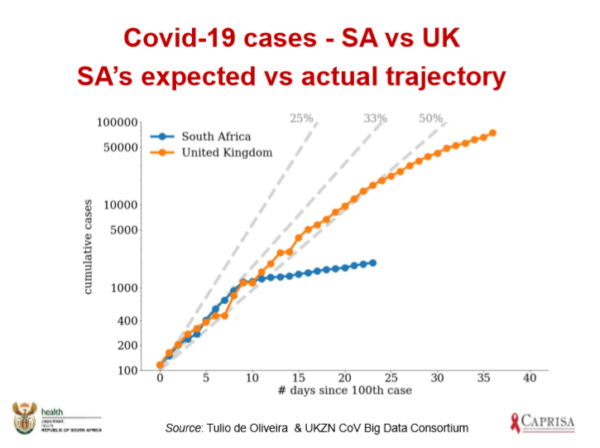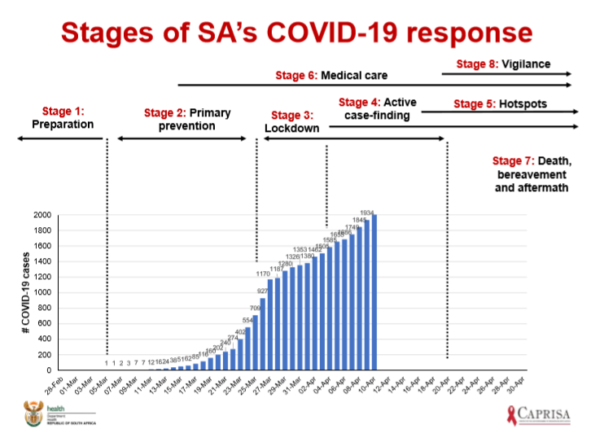South African health minister Zweli Mkhize held a live public engagement meeting this evening [13 April] with experts to discuss the technical aspects of how South Africa is responding to the COVID-19 pandemic.
According to epidemiologist and infectious diseases specialist, Professor Salim Abdool Karim, one of the experts speaking at the meeting, South Africa has had a unique epidemic trajectory of infections because the government was so quick to respond to the outbreak, especially when compared to other countries like the UK.
In the weeks leading up to the lockdown, South Africa had a similar infection trajectory to that of the UK, but as of March 26 (when the lockdown officially began), the rate of infection dramatically dropped off and reached a plateau.

Abdool Karim notes that the country has made unique moves to respond to the disease by beginning community screening in vulnerable communities.
“South Africa has a unique component to its response…we have chosen to be proactive. We’ve chosen to go out there and do active case finding.”
Professor Abdool Karim went on to explain that if the number of community transmissions remains low, the total amount of cases will decrease. If community transmission increases then the exponential rate of infections will start again, resembling the rate of infection before the lockdown was instated.
Health departments will thus continue to focus on curbing community transmission. Three high-density hubs they are focusing on include the greater Johannesburg area, greater Cape Town area and greater eThekwini area.
Professor Abdool Karim also explained the eight different stages of SA’s responses to the COVID-19 outbreak.
Stage 1– Preparation, including community education and establishing lab capacity
Stage 2– Primary prevention, including social distancing & hand-washing and closure of boarders, work places, and schools
Stage 3– Implementing the nationwide lockdown
Stage 4– Surveillance & active case-finding, Including door-to-door screening
Stage 5– Identifying hotspots including outbreak investigation & intervention teams
Stage 6– Medical Care, including building field hospitals for triage and managing staff exposures and infection
Stage 7– Bereavement & the Aftermath, including expanding burial capacity and regulations on funerals
Stage 8– Ongoing Vigilance, including the administration of vaccines, if available and ongoing surveillance for new cases

While the nationwide lockdown has undoubtedly had a positive affect on decreasing the rate of which the virus is spread, Abdool Karim states that South Africa will not be able to avoid the worst of the pandemic once the lockdown ends. A delayed exponential curve is a likely scenario.
“Our population will be at high risk again after the lockdown” said Professor Abdool Karim. The reason for this is because the virus can lay dormant in the human body for 4-7 days before symptoms show themselves ie. people can spread it without knowing.
While South Africa as a whole won’t be able to avoid the worst of the coronavirus, efforts made by the government have significantly slowed down infection rates. This is important because it gives the health care system time to flatten the curve even more. It also allows time for new, quicker and simpler diagnostics to become available, new treatments to become available, and it gives time to prepare for the medical care needs.
By April 18, there will be a clearer interpretation of whether community transmission rates are accurate. Depending on the rate of cases per day, the lockdown could either be extended or eased.
There also may be a need for a voluntary partial lockdown for citizens older than 60 and those with co-morbidities until the end of September to reduce exposure.
Minister Mkhize ended off the meeting by thanking South African citizens for their ongoing support through these trying times and urged everyone to continue to abide by the lockdown rules.
Image: Screen shot from video

